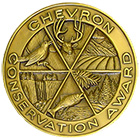Chevron Conservation Award letter from Roger Conner, American Alliance for Rights and Responsibilities, honoring Dr. John H. Tanton
American Alliance for Rights & Responsibilities
November 29, 1989
Chevron Conservation Awards Committee San Francisco, CA
Dear Friends:
Governor Richard Lamm tells me that he has nominated John Tanton for one of the Chevron Conservation Awards for this year. I am honored to submit an endorsement.
I met John when I became Executive Director of the West Michigan Environmental Action Council (WMEAC) in Grand Rapids back in 1973. John was our Northern Michigan contact person and a board member of the Michigan Environmental Protection Foundation on which I served.
He turned out to be much more than one more local activist, though he certainly was that. In those days a staff environmental job like mine took enormous amounts of time and paid very little, and I was a workaholic to boot. At least once a year, John would call and offer to take me on one of his trips -- cross country skiing in the Pictured Rocks National Lakeshore, hiking on an island in Lake Superior, sailing over to Beaver Island, to name a few. These wonderful respites from my environmental work were the only serious vacations I had in five years. These breaks gave us a chance to talk about how to educate more people to conservation values, issues on the horizon, personnel problems at WMEAC, time management and, most important, he shared his vast store of jokes for public speaking with me!
I am trying to think of a single word which characterizes John, and the word is generous. The U.S. is full of conservation activists who have made a difference and then discovered that
they rather enjoy the limelight. We are all tempted to hog it just a bit. By contrast, John is forever always pulling someone else onstage to enjoy that rush of public exposure, and then slips off to the side while they get the credit.
He focuses on people and their interests as a genuine friend, not just as people who can help with his cause. John is forever sending an unexpected news article on my special interest (baseball), a jar of honey from his apiary, beeswax candles (also from the beehives), giving me gentle encouragement to get back into exercise or take more time for vacations.
I am an example of what John has done for many professionals in the conservation movement. He contributed directly to my development while I was at WMEAC by being a regular advisor. He then convinced me that I had the potential to head a major national organization dealing with immigration and population, and encouraged me to take the step. What is more, his life as a whole gave me a model of what Aristotle called civic virtue, or what in the nineteenth century would have been called a life of scruple. In a country all too full of the self-indulgent, self-righteous, and self-important, John shows that a good life is actually restrained, humble, and centered on the community and others.
How does he do it all? Why? Those questions have puzzled many, and after fifteen years I can venture some answers, albeit tentative ones.
First, he has a deep and abiding love for the land and water resources of this country. I can still remember my astonishment at seeing him, pant legs rolled up, wading into a stream on a sub-zero morning of a winter camping expedition. He had dropped his toothbrush, and couldn't bear to leave this plastic remnant of civilization behind.
Second, he realizes that to change the world for conservation depends on a continually expanding pool of committed volunteers. He is not totally consumed with the need to convert everyone, but he is always on the lookout for people with leadership potential which they themselves often fail to recognize, and provides that boost of encouragement and support needed to get them under way.
Third, he has humility. This allows him to accept people as they are rather than make them be like him or than succumb to the self-righteousness which conservationists sometimes fall into.
This is why he can work with business people, birdwatchers, hunters, fishermen, elected officials and college professors. (This quality sometimes offends the fierce one-issue idealists who see a world made up of good guys and bad, however.)His humility also allows him to work simultaneously with a local person who is distressed about a single threatened wetland, scholars concerned about African wildlife, and the national and international leaders worried about world population growth and its impact on the environment.
Fourth, he is both creative and organized -- a rare combination of attributes. His restless intellect has caused him to found national groups on population and immigration (the Federation for American Immigration Reform), language (U.S. English, founded with S.I. Hayakawa and Alistair Cooke), and the problem; of the visually impaired (he chairs the AMA Committee on Low Vision, a new specialty in ophthalmology). How he gets it all done is a mystery to us all!
The country is fortunate that conservation has captured John's formidable energies, Petoskey is fortunate that he came there to live, and I am fortunate to know him as a friend. You would honor a great man and grace your award should you select him as a Chevron Conservationist of the year.
Sincerely,
Robert L. Conner
Curative Director

